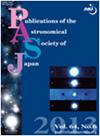Photometric and spectroscopic properties of the eclipsing system V864 Monocerotis
IF 2.2
4区 物理与天体物理
Q2 ASTRONOMY & ASTROPHYSICS
引用次数: 0
Abstract
Abstract We present the orbital period variability and evolutionary status of the W UMa-type binary system V864 Mon from accurately measured fundamental parameters. New BV photometric observations of this system were performed in 2019 January and 2022 January, and the first high-resolution spectroscopic observations were carried out on three nights between 2019 January and March. A total of 29 times of minimum light were collected to examine the behavior of the orbital period. Our analysis of these timings indicates a continuous period increase at a rate of +2.62 × 10−7 d yr−1 over the past 20 years, which can be interpreted as a mass transfer from the less massive primary to the secondary component with a rate of 1.22 × 10−7 M⊙ yr−1. We measured the radial velocities (RVs) for both components, and determined the effective temperature and projected rotational velocity of the more massive secondary star to be Teff,2 = 5450 ± 94 K and v2sin i = 192 ± 40 km s−1, respectively, from the comparison of the observed spectrum at the primary minimum and the theoretical models. The individual masses and radii of both components were determined from a simultaneous analysis of the light and RV curves, which are M1 = 0.34 ± 0.02 M⊙, R1 = 0.69 ± 0.01 R⊙, and M2 = 1.06 ± 0.04 M⊙, R2 = 1.16 ± 0.02 R⊙, respectively. Our results indicate that V864 Mon is a W-subtype of W UMa stars with time-varying spot activity. The positions in the mass-luminosity and mass-radius diagrams indicate that the secondary star belongs to the main-sequence region, while the hotter primary is located beyond the terminal-age main sequence.独角星月食系统V864的光度和光谱特性
摘要从精确测量的基本参数出发,给出了wuma型双星系统V864 Mon的轨道周期变化及其演化状态。2019年1月和2022年1月对该系统进行了新的BV光度观测,并在2019年1月至3月的三个晚上进行了首次高分辨率光谱观测。总共收集了29次最小光来检查轨道周期的行为。我们对这些时间的分析表明,在过去的20年中,周期以+2.62 × 10−7 d yr−1的速率连续增加,这可以解释为质量从质量较小的主成分向次成分的转移,速率为1.22 × 10−7 M⊙yr−1。我们测量了这两个组分的径向速度(RVs),并通过对主最小值和理论模型观测光谱的比较,确定了更大质量的副恒星Teff的有效温度和投影转速,分别为2 = 5450±94 K和v2sin i = 192±40 km s−1。同时对光和RV曲线进行分析,确定了两个组分的质量和半径,M1 = 0.34±0.02 M⊙,R1 = 0.69±0.01 R⊙,M2 = 1.06±0.04 M⊙,R2 = 1.16±0.02 R⊙。我们的结果表明,V864 Mon是wuma恒星的W亚型,具有时变的光斑活动。质量-光度图和质量-半径图的位置表明,副星属于主序区,而较热的主星位于末代主序区之外。
本文章由计算机程序翻译,如有差异,请以英文原文为准。
求助全文
约1分钟内获得全文
求助全文
来源期刊

Publications of the Astronomical Society of Japan
地学天文-天文与天体物理
CiteScore
4.10
自引率
13.00%
发文量
98
审稿时长
4-8 weeks
期刊介绍:
Publications of the Astronomical Society of Japan (PASJ) publishes the results of original research in all aspects of astronomy, astrophysics, and fields closely related to them.
 求助内容:
求助内容: 应助结果提醒方式:
应助结果提醒方式:


